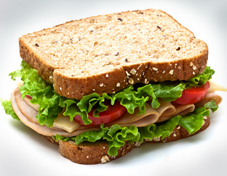Introduction
Sandwiches have long been a favourite meal option due to their versatility, convenience, and ability to cater to a wide range of tastes and dietary preferences. Whether it’s a quick lunch on a busy workday, a picnic staple, or a school lunchbox regular, sandwiches offer endless possibilities for delicious and satisfying meals. However, it’s easy to fall into the trap of unhealthy choices, often laden with processed meats, high-fat spreads, and refined breads. By making a few mindful changes, you can transform your sandwiches into nutritious, well-balanced meals that support a healthy lifestyle. In this blog, we’ll explore various healthy sandwich options that are both tasty and nourishing.
Choosing Whole Grain Breads

The foundation of a healthy sandwich starts with the bread. Choosing whole grain bread over white bread offers numerous health benefits. Whole grain breads are rich in fibre, which aids digestion, helps maintain healthy blood sugar levels, and keeps you feeling full longer. They also provide essential nutrients such as B vitamins, iron, and magnesium, which are often stripped away during the refining process used to make white bread.
When selecting whole grain breads, look for labels that list “whole grain” or “whole wheat” as the first ingredient. Some great options include whole wheat bread, rye bread, spelt bread, and multigrain bread. These varieties offer a nutty flavour and a satisfying texture that complements a wide range of sandwich fillings. Additionally, whole grain wraps and pita bread can be excellent alternatives for those who prefer a different form factor.
To ensure you’re choosing the healthiest bread possible, avoid those with added sugars, preservatives, and artificial ingredients. Freshly baked or bakery-sourced whole grain breads are often the best choice. By starting your sandwich with a nutritious base, you set the stage for a healthier meal overall.
Lean Protein Fillings
Incorporating lean proteins into your sandwich is crucial for a balanced diet. Lean proteins provide the necessary building blocks for muscle repair and growth, and they help keep you satiated throughout the day. Some excellent lean protein options for sandwiches include grilled chicken, turkey breast, tofu, and legumes such as chickpeas and black beans.
Grilled chicken sandwiches are popular choices because they are low in fat and high in protein. They can be seasoned and cooked in advance, then sliced thinly for easy sandwich assembly. Tofu, especially when marinated and grilled, offers a plant-based protein that absorbs flavours well and provides a satisfying texture. Legume-based fillings, like hummus or a black bean spread, are not only rich in protein but also in fibre, making them an excellent choice for a hearty and nutritious sandwich.
When preparing lean protein fillings, opt for grilling, baking, or steaming instead of frying to keep the fat content low. Season your proteins with herbs and spices rather than relying on high-sodium sauces or marinades. By focusing on lean protein fillings, you can create sandwiches that are both delicious and supportive of your health goals.
Incorporating Fresh Vegetables
Adding fresh vegetables to your sandwiches is an easy way to boost their nutritional value and enhance their flavour and texture. Vegetables provide essential vitamins, minerals, and antioxidants that contribute to overall health and well-being. They also add a refreshing crunch and vibrant colour to your sandwich, making it more appealing.
Leafy greens such as lettuce, spinach, and arugula are excellent choices for adding a nutritional punch. They are low in calories but high in vitamins A, C, and K, as well as folate and fibre. Tomatoes, with their juicy texture and slightly tangy taste, are a staple in many sandwiches and provide a good source of vitamin C and lycopene. Cucumbers and bell peppers add a satisfying crunch and are packed with vitamins and antioxidants.
To keep your vegetables fresh, wash and dry them thoroughly before storing them in the refrigerator. Slice or chop them just before assembling your sandwich to maintain their crispness. Incorporating a variety of fresh vegetables not only makes your sandwich more nutritious but also keeps your meals interesting and diverse.
Healthy Spreads and Condiments
Traditional spreads and condiments like mayonnaise and butter can add unnecessary fats and calories to your sandwich. Opting for healthier alternatives can significantly enhance the nutritional profile of your meal without compromising on flavour. Some excellent options include hummus, avocado, and Greek yoghurt-based spreads.
Hummus, made from blended chickpeas, tahini, lemon juice, and garlic, is a nutrient-dense spread rich in protein, fibre, and healthy fats. It adds a creamy texture and a savoury flavour that pairs well with a variety of fillings. Avocado, either sliced or mashed, provides a creamy consistency and is packed with heart-healthy monounsaturated fats, vitamins, and minerals. Greek yoghurt-based spreads can be customised with herbs, spices, and other flavourings to create a tangy, low-fat alternative to mayonnaise.
Creating your own healthy spreads at home allows you to control the ingredients and customise the flavours to your liking. For instance, a Greek yoghurt and herb spread can be made by mixing Greek yoghurt with chopped fresh herbs like dill, parsley, and chives, along with a squeeze of lemon juice and a pinch of salt. These healthier spread options not only enhance the taste of your sandwich but also contribute beneficial nutrients to your diet.
Low-Fat Cheese Options
Cheese can be a delicious addition to any sandwich, but it can also be a source of significant fat and calories. Choosing low-fat or reduced-fat cheese options can help you enjoy the flavour and creaminess of cheese without the extra calories. Some healthier cheese options include part-skim mozzarella, feta, and goat cheese.
Part-skim mozzarella is lower in fat than regular mozzarella and melts beautifully, making it ideal for hot sandwiches and paninis. Feta cheese, with its tangy flavour and crumbly texture, adds a punch of taste to cold sandwiches and salads. Goat cheese, which is naturally lower in fat than many cow’s milk cheeses, offers a creamy texture and distinctive flavour that pairs well with a variety of ingredients.
Using cheese in moderation is key to keeping your sandwich healthy. A little cheese can go a long way in adding flavour and richness, so try to use just a thin slice or a small crumble. By opting for low-fat cheese options and controlling portion sizes, you can enjoy the taste and texture of cheese while maintaining a healthier diet.
Incorporating Fruits for Natural Sweetness
Adding fruits to your sandwiches can introduce a natural sweetness that complements savoury ingredients and enhances the overall flavour profile. Fruits are not only delicious but also packed with essential vitamins, minerals, and antioxidants. Some of the best fruits for sandwiches include apple slices, berries, and figs.
Apple slices add a crisp texture and a sweet-tart flavour that pairs well with sharp cheeses and lean proteins like turkey or chicken. Berries, such as strawberries or blueberries, provide a burst of sweetness and a vibrant colour, making them a delightful addition to sandwiches with soft cheeses like brie or goat cheese. Figs, with their natural sweetness and chewy texture, can elevate a sandwich with cured meats or robust cheeses.
When incorporating fruits into your sandwiches, consider how their flavours will interact with other ingredients. Pairing sweet fruits with savoury or tangy components can create a balanced and satisfying taste experience. Experiment with different fruit combinations to discover new and exciting flavours that make your sandwiches both nutritious and enjoyable.
Whole Food Additions
Incorporating whole food ingredients into your sandwiches can significantly boost their nutritional value and contribute to a balanced diet. Whole foods, such as nuts, seeds, and sprouts, provide essential nutrients, including healthy fats, protein, and fibre. They also add interesting textures and flavours to your sandwich.
Nuts and seeds, such as sliced almonds, sunflower seeds, or chia seeds, can add a delightful crunch and a dose of healthy fats and protein. They pair well with both sweet and savoury sandwiches, adding texture and nutritional benefits. Sprouts, such as alfalfa, broccoli, or mung bean sprouts, are rich in vitamins and minerals and offer a fresh, crisp element that enhances the overall texture of your sandwich.
Incorporating whole food additions into your sandwiches is an easy way to enhance their nutritional profile without adding processed ingredients. These ingredients are minimally processed and retain their natural nutrients, making them a healthy choice for any meal. By including a variety of whole foods in your sandwiches, you can create meals that are both satisfying and nourishing.
Using Alternative Wraps
For those looking to reduce their intake of refined carbohydrates or simply seeking variety, using alternative wraps instead of traditional bread can be a great option. Alternative wraps, such as lettuce wraps, whole grain wraps, and cauliflower wraps, offer different textures and nutritional benefits.
Lettuce wraps, using large, sturdy leaves like romaine or iceberg, provide a low-calorie, low-carb alternative to bread. They are perfect for holding a variety of fillings and add a refreshing crunch. Whole grain wraps, made from whole wheat or other whole grains, offer the benefits of fibre and nutrients while still providing the convenience of a traditional wrap. Cauliflower wraps, which can be made at home or purchased pre-made, are a gluten-free option that provides a neutral flavour and a sturdy base for your sandwich fillings.
Preparing and using alternative wraps is straightforward and can add variety to your sandwich repertoire. Simply choose your preferred wrap, fill it with your favourite healthy ingredients, and enjoy a nutritious and satisfying meal. These alternative wraps can cater to different dietary needs and preferences, making them a versatile choice for healthy sandwiches.
Portion Control and Balanced Meals
Maintaining portion control is essential for a balanced diet and overall health. Even healthy sandwiches can become calorie-dense if portions are too large or if too many ingredients are added. Focusing on creating balanced meals with appropriate portion sizes ensures that your sandwich is both nutritious and satisfying without being overly caloric.
A well-portioned sandwich typically includes a reasonable amount of protein, a variety of vegetables, a modest portion of healthy fats, and whole grain bread or an alternative wrap. Aim for about 3-4 ounces of lean protein, 1-2 ounces of cheese, and plenty of vegetables. Using smaller, more nutrient-dense breads or wraps can help keep the calorie count in check while providing essential nutrients.
Creating balanced meals involves pairing your sandwich with healthy sides, such as a small salad, a piece of fruit, or a handful of nuts. This approach ensures that you are getting a variety of nutrients and staying within your caloric needs. By practising portion control and focusing on balanced meals, you can enjoy your sandwiches as part of a healthy and sustainable diet.
Preparing Sandwiches Ahead of Time
Meal prepping healthy sandwiches in advance can save time and ensure that you always have a nutritious meal ready to go. Preparing sandwiches ahead of time allows you to control the ingredients and portions, making it easier to stick to your dietary goals.
To prepare sandwiches ahead of time, start by choosing ingredients that store well, such as lean proteins, sturdy vegetables, and whole grain breads or wraps. Assemble your sandwiches and store them in airtight containers or wrap them tightly in cling film to keep them fresh. For ingredients that may cause sogginess, such as tomatoes or spreads, consider adding them just before eating.
Storing your prepped sandwiches in the refrigerator ensures they stay fresh and ready to eat. You can also freeze sandwiches that don’t contain fresh vegetables or delicate ingredients, and thaw them as needed. By preparing sandwiches ahead of time, you can ensure that you always have a healthy and convenient meal option available, making it easier to maintain a nutritious diet.
Conclusion
Making healthy sandwich choices is a simple yet effective way to support your overall health and well-being. By choosing whole grain breads, lean protein fillings, fresh vegetables, and healthy spreads, you can create delicious and nutritious sandwiches that cater to your dietary preferences and goals. Incorporating fruits, whole foods, and alternative wraps adds variety and nutritional benefits, while practising portion control ensures balanced meals. Preparing sandwiches ahead of time makes healthy eating convenient and manageable. Embrace these tips and tricks to enjoy satisfying and nourishing sandwiches that fuel your body and delight your taste buds.
Meta Description
Discover healthy sandwich options with tips on whole grain breads, lean proteins, fresh vegetables, and more. Create delicious, balanced, and nutritious sandwiches easily.




Leave a Reply